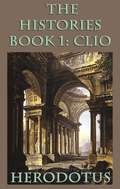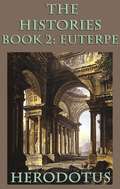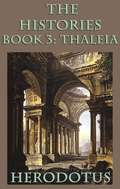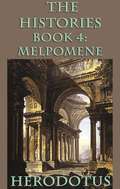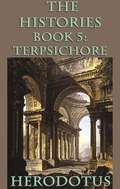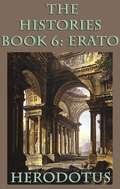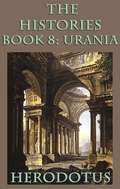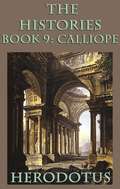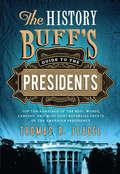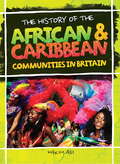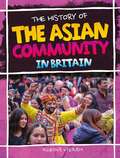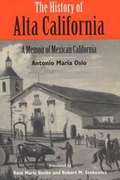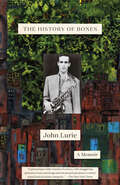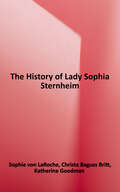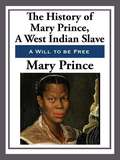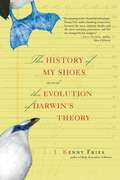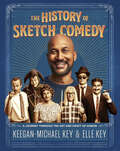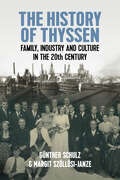- Table View
- List View
The Histories Book 1: Clio
by HerodotusHerodotus was an ancient Greek historian who lived in the fifth century BC (c.484 - 425 BC). He has been called the "Father of History", and was the first historian known to collect his materials systematically, test their accuracy to a certain extent and arrange them in a well-constructed and vivid narrative. The Histories-his masterpiece and the only work he is known to have produced-is a record of his "inquiry", being an investigation of the origins of the Greco-Persian Wars and including a wealth of geographical and ethnographical information. The Histories, were divided into nine books, named after the nine Muses: the "Muse of History", Clio, representing the first book, then Euterpe, Thaleia, Melpomene, Terpsichore, Erato, Polymnia, Ourania and Calliope for books 2 to 9, respectively.
The Histories Book 2: Euterpe
by HerodotusHerodotus was an ancient Greek historian who lived in the fifth century BC (c.484 - 425 BC). He has been called the "Father of History", and was the first historian known to collect his materials systematically, test their accuracy to a certain extent and arrange them in a well-constructed and vivid narrative. The Histories-his masterpiece and the only work he is known to have produced-is a record of his "inquiry", being an investigation of the origins of the Greco-Persian Wars and including a wealth of geographical and ethnographical information. The Histories, were divided into nine books, named after the nine Muses: the "Muse of History", Clio, representing the first book, then Euterpe, Thaleia, Melpomene, Terpsichore, Erato, Polymnia, Ourania and Calliope for books 2 to 9, respectively.
The Histories Book 3: Thaleia
by HerodotusHerodotus was an ancient Greek historian who lived in the fifth century BC (c.484 - 425 BC). He has been called the "Father of History", and was the first historian known to collect his materials systematically, test their accuracy to a certain extent and arrange them in a well-constructed and vivid narrative. The Histories-his masterpiece and the only work he is known to have produced-is a record of his "inquiry", being an investigation of the origins of the Greco-Persian Wars and including a wealth of geographical and ethnographical information. The Histories, were divided into nine books, named after the nine Muses: the "Muse of History", Clio, representing the first book, then Euterpe, Thaleia, Melpomene, Terpsichore, Erato, Polymnia, Ourania and Calliope for books 2 to 9, respectively.
The Histories Book 4: Melpomene
by HerodotusHerodotus was an ancient Greek historian who lived in the fifth century BC (c.484 - 425 BC). He has been called the "Father of History", and was the first historian known to collect his materials systematically, test their accuracy to a certain extent and arrange them in a well-constructed and vivid narrative. The Histories-his masterpiece and the only work he is known to have produced-is a record of his "inquiry", being an investigation of the origins of the Greco-Persian Wars and including a wealth of geographical and ethnographical information. The Histories, were divided into nine books, named after the nine Muses: the "Muse of History", Clio, representing the first book, then Euterpe, Thaleia, Melpomene, Terpsichore, Erato, Polymnia, Ourania and Calliope for books 2 to 9, respectively.
The Histories Book 5: Tersichore
by HerodotusHerodotus was an ancient Greek historian who lived in the fifth century BC (c.484 - 425 BC). He has been called the "Father of History", and was the first historian known to collect his materials systematically, test their accuracy to a certain extent and arrange them in a well-constructed and vivid narrative. The Histories-his masterpiece and the only work he is known to have produced-is a record of his "inquiry", being an investigation of the origins of the Greco-Persian Wars and including a wealth of geographical and ethnographical information. The Histories, were divided into nine books, named after the nine Muses: the "Muse of History", Clio, representing the first book, then Euterpe, Thaleia, Melpomene, Terpsichore, Erato, Polymnia, Ourania and Calliope for books 2 to 9, respectively.
The Histories Book 6: Erato
by HerodotusHerodotus was an ancient Greek historian who lived in the fifth century BC (c.484 - 425 BC). He has been called the "Father of History", and was the first historian known to collect his materials systematically, test their accuracy to a certain extent and arrange them in a well-constructed and vivid narrative. The Histories-his masterpiece and the only work he is known to have produced-is a record of his "inquiry", being an investigation of the origins of the Greco-Persian Wars and including a wealth of geographical and ethnographical information. The Histories, were divided into nine books, named after the nine Muses: the "Muse of History", Clio, representing the first book, then Euterpe, Thaleia, Melpomene, Terpsichore, Erato, Polymnia, Ourania and Calliope for books 2 to 9, respectively.
The Histories Book 7: Polymnia
by HerodotusHerodotus was an ancient Greek historian who lived in the fifth century BC (c.484 - 425 BC). He has been called the "Father of History", and was the first historian known to collect his materials systematically, test their accuracy to a certain extent and arrange them in a well-constructed and vivid narrative. The Histories-his masterpiece and the only work he is known to have produced-is a record of his "inquiry", being an investigation of the origins of the Greco-Persian Wars and including a wealth of geographical and ethnographical information. The Histories, were divided into nine books, named after the nine Muses: the "Muse of History", Clio, representing the first book, then Euterpe, Thaleia, Melpomene, Terpsichore, Erato, Polymnia, Ourania and Calliope for books 2 to 9, respectively.
The Histories Book 8: Urania
by HerodotusHerodotus was an ancient Greek historian who lived in the fifth century BC (c.484 - 425 BC). He has been called the "Father of History", and was the first historian known to collect his materials systematically, test their accuracy to a certain extent and arrange them in a well-constructed and vivid narrative. The Histories-his masterpiece and the only work he is known to have produced-is a record of his "inquiry", being an investigation of the origins of the Greco-Persian Wars and including a wealth of geographical and ethnographical information. The Histories, were divided into nine books, named after the nine Muses: the "Muse of History", Clio, representing the first book, then Euterpe, Thaleia, Melpomene, Terpsichore, Erato, Polymnia, Ourania and Calliope for books 2 to 9, respectively.
The Histories Book 9: Calliope
by HerodotusHerodotus was an ancient Greek historian who lived in the fifth century BC (c.484 - 425 BC). He has been called the "Father of History", and was the first historian known to collect his materials systematically, test their accuracy to a certain extent and arrange them in a well-constructed and vivid narrative. The Histories-his masterpiece and the only work he is known to have produced-is a record of his "inquiry", being an investigation of the origins of the Greco-Persian Wars and including a wealth of geographical and ethnographical information. The Histories, were divided into nine books, named after the nine Muses: the "Muse of History", Clio, representing the first book, then Euterpe, Thaleia, Melpomene, Terpsichore, Erato, Polymnia, Ourania and Calliope for books 2 to 9, respectively.
The History Buff's Guide to the Presidents
by Thomas R. FlagelAmericans have named schools, counties, rivers, cities, and even their own children after U. S. presidents. Their work is in our laws, their words adorn our monuments, and their countenances appear in a trillion places (mostly on our currency). As we prepare to decide who will be the 44th president of the United States, can we truly say we understand the office and its phenomenal history? What do we really know about the men who helped transform a struggling republic into a superpower?Using detailed top-ten lists, historian Thomas R. Flagel offers a provocative new look at an astonishingly resilient institution. With diligent research, he explores the best, worst, largest, and most controversial facets of an office that some feared would become a monarchy, others hoped would represent all of the people, and John Adams wanted to call "High Highness, the President of the United States of America, and the Protector of their Liberties. "Chapters include: - Elections: the closest races, the most vicious campaigns, and the biggest landslidesPresidential Character: careers, hobbies, the most religious presidents, and the Machiavellians - The Domestic Sphere: the biggest deficit spenders, the most ambitious programs, vetoes, pardons, and the worst fights with the Superme Courts - Foreign Affairs: diplomats, doctrines, and ranking the commanders in chief - The Inner Circle: first ladies and vexing relatives, construction and destruction in the White House, scandals at the highest level, and the real West WingI - n Retrospect: the most underrated and overrated presidents, assassinations and attempted assassinations, and the greatest changes to the presidency itself
The History Of The African & Caribbean Communities In Britain (The History Of #1)
by Hakim AdiDiscover the fascinating history of African and Caribbean communities in Britain, from pre-Roman times to the 21st Century.Newly updated, The History of African and Caribbean Communities in Britain explores why people came to Britain, the problems they faced and the contributions these communities have made to British society. Brought to life with case studies and rarely published photographs, this is an opportunity to get up close to the experiences and vital impact African and Caribbean people have had in Britain. Meet pioneers such as Olaudah Equiano and Phyllis Wheatley and find out why African and Caribbean communities have been fundamental to Britain's success on the world stage. Written by British historian and academic Prof. Hakim Adi, a specialist on the history of Africa and the African diaspora, this book is essential reading for children aged 11+ and anyone interested in learning about the history of these communities in Britain.
The History Of The Asian Community In Britain (The History Of #2)
by Rozina VisramDiscover the fascinating history of the Asian community in Britain, from the first settlers to the 21st Century.Newly updated, The History of the Asian Community in Britain explores why people came to Britain, the problems they faced and the contributions these communities have made to British society. Brought to life with case studies and rarely published photographs, this is an opportunity to get up close to the experiences and vital impact Asian people have had in Britain. Meet pioneers such as Sake Dean Mahomed and Jayaben Desai and find out why the Asian community has been fundamental to Britain's success on the world stage.
The History of Alta California
by Antonio María OsioAntonio María Osio’s La Historia de Alta California was the first written history of upper California during the era of Mexican rule, and this is its first complete English translation. A Mexican-Californian, government official, and the landowner of Angel Island and Point Reyes, Osio writes colorfully of life in old Monterey, Los Angeles, and San Francisco, and gives a first-hand account of the political intrigues of the 1830s that led to the appointment of Juan Bautista Alvarado as governor. Osio wrote his History in 1851, conveying with immediacy and detail the years of the U.S.-Mexican War of 1846–1848 and the social upheaval that followed. As he witnesses California’s territorial transition from Mexico to the United States, he recalls with pride the achievements of Mexican California in earlier decades and writes critically of the onset of U.S. influence and imperialism. Unable to endure life as foreigners in their home of twenty-seven years, Osio and his family left Alta California for Mexico in 1852. Osio’s account predates by a quarter century the better-known reminiscences of Mariano Guadalupe Vallejo and Juan Bautista Alvarado and the memoirs of Californios dictated to Hubert Howe Bancroft’s staff in the 1870s. Editors Rose Marie Beebe and Robert M. Senkewicz have provided an accurate, complete translation of Osio’s original manuscript, and their helpful introduction and notes offer further details of Osio’s life and of society in Alta California.
The History of Bones: A Memoir
by John LurieThe quintessential depiction of 1980s New York and the downtown scene from the artist, actor, musician, and composer John Lurie&“Ferocious and wise, funny and tragic, raging and forgiving, and I loved every page.&”—Nick Flynn, author of Another Bullshit Night in Suck CityIn the tornado that was downtown New York in the 1980s, John Lurie stood at the vortex. After founding the band The Lounge Lizards with his brother, Evan, in 1979, Lurie quickly became a centrifugal figure in the world of outsider artists, cutting-edge filmmakers, and cultural rebels. Now Lurie vibrantly brings to life the whole wash of 1980s New York as he developed his artistic soul over the course of the decade and came into orbit with all the prominent artists of that time and place, including Andy Warhol, Debbie Harry, Boris Policeband, and, especially, Jean-Michel Basquiat, the enigmatic prodigy who spent a year sleeping on the floor of Lurie&’s East Third Street apartment. It may feel like Disney World now, but in The History of Bones, the East Village, through Lurie&’s clear-eyed reminiscence, comes to teeming, gritty life. The book is full of grime and frank humor—Lurie holds nothing back in this journey to one of the most significant moments in our cultural history, one whose reverberations are still strongly felt today. History may repeat itself, but the way downtown New York happened in the 1980s will never happen again. Luckily, through this beautiful memoir, we all have a front-row seat.
The History of Democracy Has Yet to Be Written: How We Have to Learn to Govern All Over Again
by Thomas Geoghegan&“This book made me laugh out loud and also gave me glimpses of an entire horizon of possibility I hadn&’t seen before.&”—Chris Hayes, host of MSNBC&’s All In with Chris Hayes End the filibuster. Abolish the Senate. Make everyone vote. Only if we do this (and then some), says Thomas Geoghegan, might we heal our fractured democracy. In 2008, Geoghegan―then an established labor lawyer and prolific writer―embarked on a campaign to represent Chicago&’s Fifth District in Congress, in a special election called when Rahm Emanuel stepped down to serve as President Barack Obama&’s chief of staff. For ninety days leading up to the election, Geoghegan, a political neophyte at age sixty, knocked on doors, shook hands at train stations, and made fundraising calls. On election night he lost, badly. But this humbling experience helped him develop a framework for reimagining American government in a way that is truly just, fair, and constitutional. Taking its title from Walt Whitman, The History of Democracy Is Yet to Be Written: How We Have to Learn to Govern All Over Again, combines hilarious tales from his time on the campaign trail with an incisive vision of how we might be able to create an America that fulfills its great promise. In a polarized country, where 100 million citizens don&’t vote, and those who do are otherwise rarely politically engaged, he makes an impassioned case for the possibility of a truly representative democracy, one built on the ideals of the House of Representatives, the true chamber of the people, and inspired by the poet who gives the book its name. At once an engaging memoir and a call to arms, The History of Democracy Is Yet to Be Written will inspire and invigorate political veterans and young activists alike. &“Witty, succinct . . . morally incisive.&” —Rick Perlstein, New York Times–bestselling author of Reaganland &“Geoghegan&’s punchy political memoir-and-manifesto is hilarious, poignant, and rippling with strong ideas and practical hope for change.&” —Congressman Jamie Raskin
The History of Lady Sophia Sternheim: Extracted by a Woman Friend of the Same from Original Documents and Other Reliable Sources
by Sophie Von LaRocheThis is the first translation of this work into English since 1776, and the only English version that is complete and unadulterated. Sophie von LaRoche is credited with being the first German female novelist and author of the first German "woman's novel." The History of Lady Sophia Sternheim is the first German Bildungsroman with a female protagonist, the first full-fledged German epistolary novel, and the first German sentimental novel. Its autobiographical aspects, incorporating thinly disguised vignettes of Wieland, Goethe, and other great figures of the day, give the work an unmistakably true-to-life flavor and immediacy.
The History of Mary Prince, a West Indian Slave
by Mary PrinceMary Prince was the first woman slave to write of her experience. Her recollections are vivid, powerful, and lyrical. Upon its publication the book had a galvanizing effect on the abolitionist movement in England.
The History of Mary Prince: A West Indian Slave
by Mary PrinceThe History of Mary Prince (1831) was the first narrative of a black woman to be published in Britain. It describes Prince's sufferings as a slave in Bermuda, Turks Island and Antigua, and her eventual arrival in London with her brutal owner Mr Wood in 1828. Prince escaped from him and sought assistance from the Anti-Slavery Society, where she dictated her remarkable story to Susanna Strickland (later Moodie). A moving and graphic document, The History drew attention to the continuation of slavery in the Caribbean, despite an 1807 Act of Parliament officially ending the slave trade. It inspired two libel actions and ran into three editions in the year of its publication. This powerful rallying cry for emancipation remains an extraordinary testament to Prince's ill-treatment, suffering and survival.
The History of My Shoes and the Evolution of Darwin's Theory
by Kenny Fries<p>In The History of My Shoes, Kenny Fries narrates two stories: the development of the theory of "survival of the fittest," as articulated by Charles Darwin and Alfred Russel Wallace; and the history of his ever-changing, made-to-order, orthopedic shoes. <p>The famously important first story, as told by Kenny Fries, is a condensed and colorful account of the race between Darwin and Wallace to formulate their groundbreaking theories. <p>At the same time, Fries, a gay and disabled man, tells a deeply personal story of the evolving consciousness of his own "adaptations," represented by his shoes. As a child, Fries was abused by both his father and brother, and emerged into adulthood swaddled in ambiguities of self and memory. <p>These he has explored in his brutally frank memoir, Body, Remember. In this poetic, introspective book, Kenny Fries imaginatively illustrates how his identities intersect. He writes, "Much of my own work the past fifteen years has been concerned with the body, as both subject and metaphor; as the place where the personal becomes the universal; as the site of memory, language, and desire." <P>Although only the "fittest" may survive, Fries learns that adaptation and variation are critical to survival. What is deemed normal, or even perfect, are passing phases of the ever-changing embodiment of nature in our world. In the end, Darwin and Wallace's discoveries resonate with Fries's own story in The History of My Shoes.
The History of Sketch Comedy: A Journey through the Art and Craft of Humor
by Keegan-Michael Key Elle Key"A boisterous debut … the authors are as funny as one would expect … this is a hoot.” ―Publishers Weekly “Will entice fans of Key & Peele … a fun and funny primer on the art form.” ―BooklistAuthors Keegan-Michael Key and Elle Key build on the popularity of their 2022 Webby Award–winning podcast and delve deeper into the world of sketch, helped along with new essays created expressly for the book by comedy greats.The History of Sketch Comedy will appeal to all kinds of comedy fans as well as fans of Keegan-Michael Key, whether they know him from his Emmy and Peabody-winning work on Key & Peele; his roles in Fargo, The Prom, Schmigadoon!, The Bubble, and the upcoming Wonka; voiceover work in The Lion King; or as President Barack Obama's anger translator, Luther.With epic personal tangents and hilarious asides, the Keys take you on an illuminating journey through all facets of comedy from the stock characters of commedia del arte in the 16th century, to the rise of vaudeville and burlesque, the golden age of television comedy, the influence of the most well-known comedy schools, and the ascension of comedy films and TV specials—all the way through to a look at the future of sketch on social media platforms. Along the way, we hear tales of Keegan's childhood, his comedy influences, and the vicissitudes of his career path. As the New York Times said in its review of their podcast, "this comedy nerd history is filtered through memoir, with Key relating stories of his budding fandom, training and rise from improv comic to television sketch artist."Part memoir, part masterclass, and hilariously embellished with priceless commentary, The History of Sketch Comedy highlights the essential building blocks of sketch comedy while interweaving Keegan's personal career journey and the influence of his comedy heroes. The text is complemented by original art by Elle Key and exclusive essays compiled from conversations with influential performers, sketch writers, and uber comedy fans including Mel Brooks, Julia Louis-Dreyfus, Mike Myers, Chris Rock, John Oliver, Tracy Morgan, Carol Burnett, Jim Carrey, Jordan Peele, and many more. This book is as entertaining as it is enlightening—a must-read for fans of comedy and all who aspire to comic greatness.EXPANDING THE HIT PODCAST: With content from the #1 trending, NAACP-award-nominated and Webby-Award-winning Audible podcast, and featuring new-for-the-book material as well as never-before-heard stories and essays, this book will be a hit for newcomers and avid listeners of the podcast alike.MASTER OF THE MEDIUM: Keegan-Michael Key is a bona fide maestro of comedy, with the chops, experience, and love for the history of the medium that make him the perfect expert on all things sketch. As co-writer Elle Key likes to say, "If Keegan-Michael Key was a guest lecturer at NYU teaching a course called 'The History of Sketch Comedy,' it would be a very popular class."EXCLUSIVE ESSAYS: Keegan and Elle interviewed over a dozen comedy legends exclusively for this book, and got their takes on topics ranging from the influence of Saturday Night Live, to women in comedy, to the mathematics of sketch. Hear, in their own words, from Mel Brooks, Mike Myers, Jordan Peele, Julia-Louis Dreyfus, John Oliver, Tracy Morgan, Stephen Colbert, Carol Burnett, Chris Rock, Bob Odenkirk, Mike Birbiglia, Matt Lucas, Ken Jeong, Christopher Guest, Gary Oldman, Kevin Nealon, Laraine Newman, and Jim Carrey.GIFTABLE VOLUME OF COMEDY GOLD: Original illustrations and personal photographs throughout make this unique comedy book as visually entertaining as it is enlightening. The perfect gift for comedy fans of a
The History of Thyssen: Family, Industry and Culture in the 20th Century
by Günther Schulz Margit Szöllösi-JanzeAs a result of a multi-volume research project, funded by the Thyssen Foundations (Stiftung zur Industriegeschichte Thyssen and Fritz Thyssen Stiftung), ten books were published that served to greatly advance the available knowledge on the Thyssen family and their companies. The results of this project are summarized in this volume which provides both an explanation of how the project was conceptualized and executed and a detailed case study of a family and their business during the late-nineteenth and twentieth centuries. It explains the development of both whilst addressing issues such as patriarchal succession; gender roles in the family; wealthy lifestyles in international communities of aristocrats and diplomats; operating across national legislation, institutions, and policies; and discussions of labor and capital. In doing so it connects corporate and family history to provide an all-inclusive view of the development of a business.
